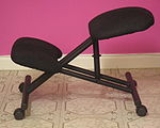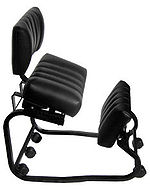
Kneeling chair
Encyclopedia

Chair
A chair is a stable, raised surface used to sit on, commonly for use by one person. Chairs are most often supported by four legs and have a back; however, a chair can have three legs or could have a different shape depending on the criteria of the chair specifications. A chair without a back or...
for sitting
Sitting
Sitting is a rest position supported by the buttocks or thighs where the torso is more or less upright.- Sitting on the floor :The most common way of sitting on the floor involves bending the knees...
in a position
Human position
Human positions refers to the different positions that the human body can take.There are several synonyms that refer to the human position, often used interchangeably, but having specific flavors....
with the thigh
Thigh
In humans the thigh is the area between the pelvis and the knee. Anatomically, it is part of the lower limb.The single bone in the thigh is called the femur...
s dropped to an angle of about 60 to 70 degrees from vertical (as opposed to 90 degrees when sitting in a normal chair), with some of the body
Human body
The human body is the entire structure of a human organism, and consists of a head, neck, torso, two arms and two legs.By the time the human reaches adulthood, the body consists of close to 100 trillion cells, the basic unit of life...
's weight supported by the shin
Tibia
The tibia , shinbone, or shankbone is the larger and stronger of the two bones in the leg below the knee in vertebrates , and connects the knee with the ankle bones....
s. The original kneeling chair was the Balans chair, which was developed in 1979 by Hans Christian Mengshoel and designer Peter Opsvik
Peter Opsvik
Peter Opsvik is a Norwegian industrial designer best known for his innovative and ergonomic chairs. Opsvik’s furniture can be found under the brand names: Rybo , Håg , Varier , Stokke Naturellement , Cylindra and Moment .His book Rethinking Sittingcame out in 2009 giving...
.

A proper kneeling chair creates the open body angle by lowering the angle of the lower body, keeping the spine in alignment and the sitter properly positioned to task. The benefit of this position is that if one leans inward, the body angle remains 90 degrees or wider. A misconception regarding kneeling chairs is that the body's weight bears on the knees, and thus users with poor knees cannot use the chair. In a proper kneeling chair, some of the weight bears on the shins, not the knees, but the primary function of the shin rests (knee rests) are to keep one from falling forward out of the chair. Most of the weight remains on the buttocks. Another way to keep the body from falling forward is with a saddle chair
Saddle chair
A saddle chair uses the same principles in its design as an equestrian saddle. It does not have a backrest but is equipped with a chair base on castors and a gas cylinder for adjusting the correct sitting height. The castors enable moving around and reaching out for e.g. tools while...
. This type of seat is generally seen in some sit stand stools, which seek to emulate the riding or saddle position of a horseback rider, the first "job" involving extended periods of sitting.
Academic studies
Ericson and Goldie studied spinal shrinkage in subjects using three different types of chairs while performing video display unit work and, in an eight-person study, found that subjects shrank more when sitting on a forward sloping chair with knee support than on a conventional chair.Drury and Francher studied the original Balans kneeling chair in 1985, concluding that overall it was "no better than conventional chairs and could be worse than well-designed conventional office chairs." Lander et al. conducted another experiment in 1987 comparing the kneeling chair with a conventional chair and concluded that their experimental data "do not support the manufacturer's claim that the Balans chair is likely to decrease complaints of [lower-back pain]".
A 1989 study on a sample of 20 subjects concluded that the Balans chair promoted greater lumbar curvature than the "straight back chair" during relaxed sitting, typing and writing and that it could contribute to treatment of lower back injuries. A more recent study from 2008 confirms that "ergonomically designed kneeling chairs set at +20 degrees inclination do maintain standing lumbar curvature to a greater extent than sitting on a standard computer chair."

